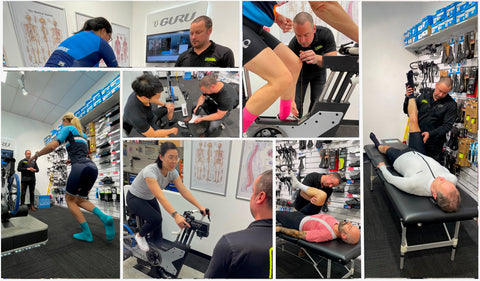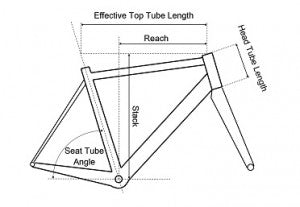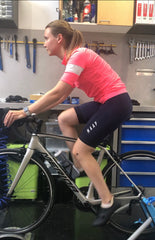

Best Bike Fitting in Melbourne
Our long history and experience with bike fitting, spacious fit studio and Guru machine uniquely qualify us to offer the highest level bike fit. Located in Melbourne, our professional and detailed services can help you get the most from your biking experience. Our GURU Dynamic Fitting Unit helps us dial in positions while the rider is in motion, a unique experience in the bike fitting world. It also gives us live power, cadence and other feedback that helps us understand the impact that changes make in real time. We are currently accepting bookings for fits
Learn about the GURU experience
Call to book a fit with us today – 03 9557 6461
About Bike Fitting:
A true bike fit is about making a bike and equipment fit the rider and all of their abilities, limitations, and aspirations. Each person is unique and comes with a different set of challenges in flexibility, range of motion, history of injuries and comfort levels. A good bike fit is one that measures and considers all of these before making any adjustments to the equipment. Anything less is a “bike sizing” and may come in many different levels of complexity.



Bike fitting requires everything from an understanding of the dynamics of muscle recruitment into the pedal strokes, to the muscle and skeletal structure, to geometries of various bikes
Bike fitting is a comprehensive process and varies a bit depending on where you get your fit but almost ALL bikefitting methodologies share the same foundation principles. Some hallmarks of a solid bike fit are a pre-fit interview, physical assessment off the bike, on-bike review, equipment alterations, and some level of post-fit followups. Bike fits take anywhere from one to four hours to complete and can lead to some major revelations in your knowledge about your body-bike interface. Along with a more detailed side analysis like in the bike sizing, the fitter analyses and can optimise the front view which includes the hip/knee/foot alignment for maximum pedal efficiency. It’s the best way to address niggling pains, discomfort and most importantly to get the most power and speed from your machine. During the bike fit process you may find that you require some major modifications to your equipment that might include bars, stem, shoes, cleats, pedals, footbeds and saddle. As you can imagine, these things can add up, but anyone who has invested in and benefited from a bike fit will tell you that it’s worth as much as the bike itself. Bike fits are available from most high level bike shops, but also are on offer from many medical professionals and personal trainers with biking experience. The benefit of getting a fit at a bike shop with highly trained fitters is the access to product and tools to help maximise the fit’s results and the retailer’s knowledge of equipment and technology that might be available to optimise your efficiency or position.

About your Bike Fitter
A good bike fitter is part bike mechanic, equipment consultant, PT, coach, counsellor, personal trainer, and anatomical expert. And at some point, you may need to also see one of these other more highly trained specialists. Bike fitting requires a knowledge of bike fitting methodologies, yes, but also a lot more. A good understanding of bike geometry, accessories, compatibility, and products related to fitting, then having access to all the tools and products to complete a fit is something you can only find in a bike shop that specialises in bike fitting. Making the bike fit the rider, with all the brands, sizes, and plethora of models that we are presented with in our shop takes years and years of experience to manage. Finding someone with all the riding experience, fitting training, and bike mechanical knowledge is unique, and we have it here at Urban Pedaler.
Ladies, if you are reading, check out our more in-depth saddle information here
Who should get a bike fit?
We’ve all seen people with visually unnatural pedal strokes, but those are the just the most obvious. Many of us live with slight abnormalities that affect us in ways that we can not see or have adjusted to over time like leg length discrepancies, limited flexibility, surgeries, injuries, and pain. We hear “it’s always been like that”, or “I’ve learned to live with it”, and these are never excuses to ignore the ability to improve your position. After seeing riders from all walks of life benefit from fitting, our experience tell us that anyone who enjoys their time in the saddle should consider it.



Bike Sizing
Bike sizing is something that typically comes free with a bike purchase, and usually includes at least adjustments to the seat height. Looking at a rider from the side, a person with good experience can adjust the seat height, the seat fore/aft, and the reach to the handlebar to get a rider into a “ballpark” position. This is where they are getting full leg extension and power from the pedal stroke and are comfortable with their extension to the handlebars. This is usually achievable with the existing equipment on the bike but might necessitate a change in the stem length to extend or reduce the reach. A fitter might take some time and use some specialised tools to achieve this position, but it is not an overly complex process and therefore ranges in cost from free to $150 depending on the skill level of the fitter, any specialized equipment used, and the time it takes. Most bikes from most manufacturers have enough sizes available and the right component specification that you can get near-optimum performance from an off-the-shelf bike and a good bike sizing from your shop.




